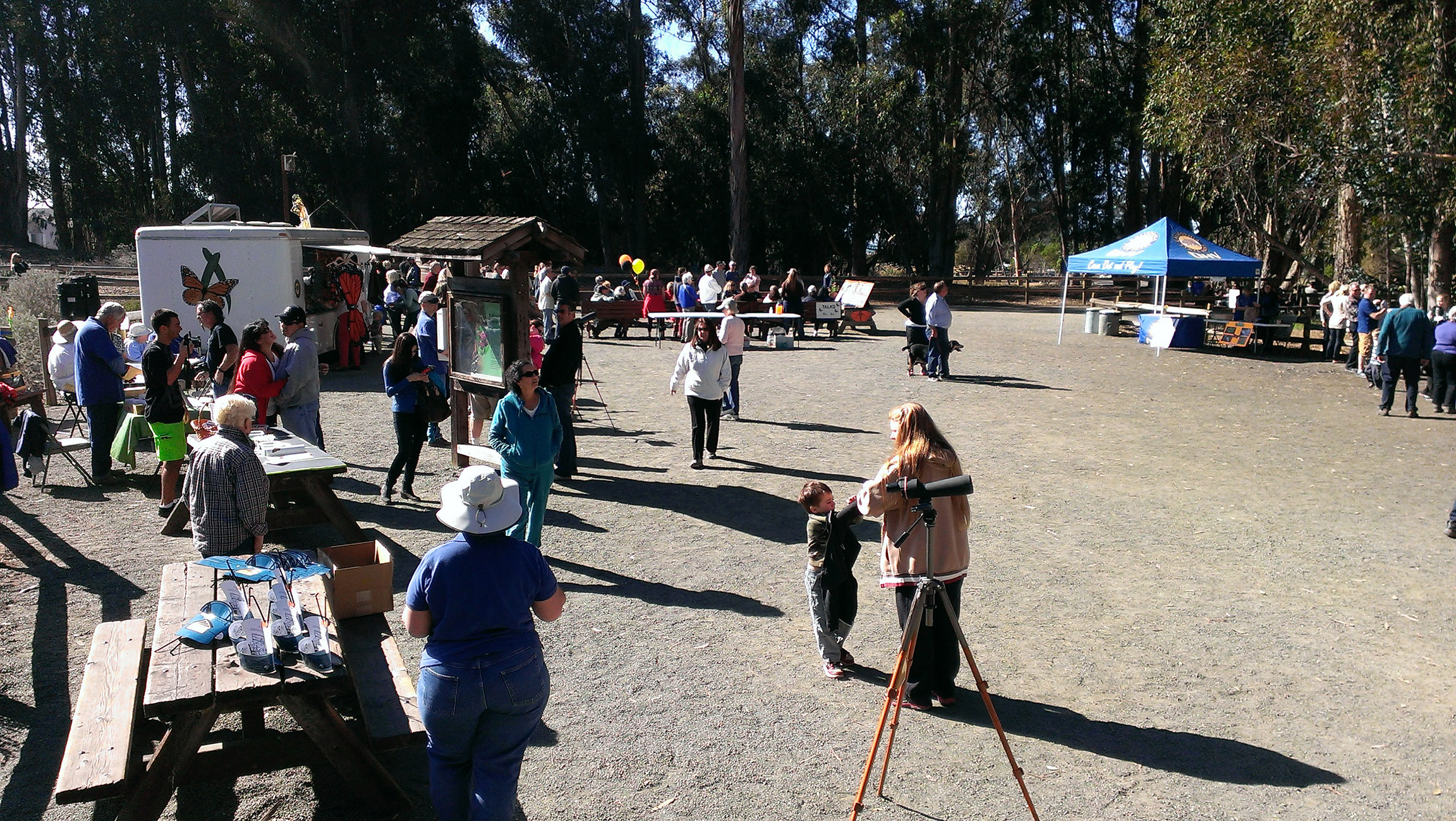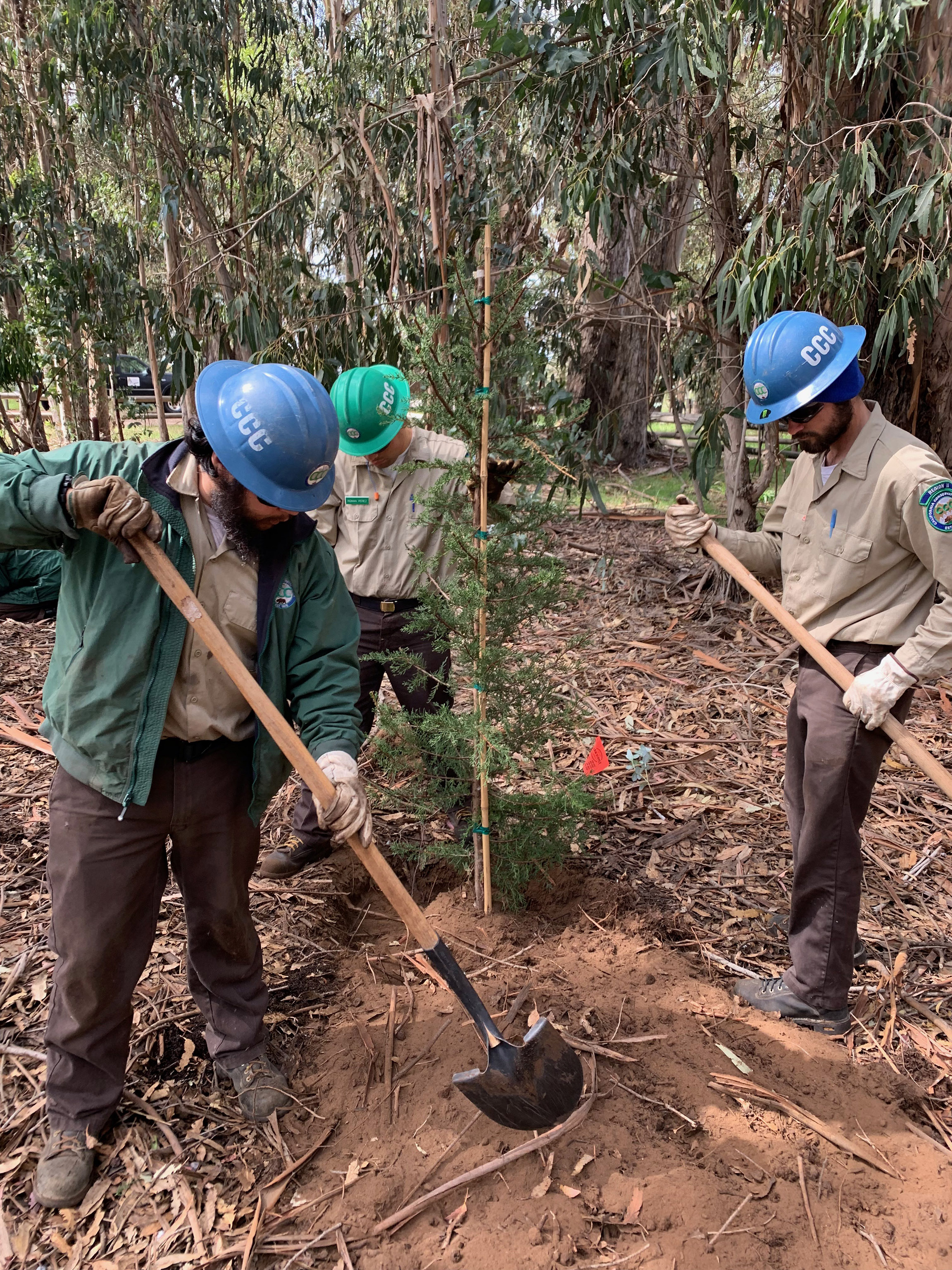Pismo State Beach Takes Steps to Protect and Restore Monarch Overwintering Habitat
Each year, monarch butterflies from across western North America make their incredible migration to California to spend the winter in groves of trees along the coast. There are hundreds of such groves, but one of the most important is a nondescript stand of eucalyptus and Monterey cypress trees sandwiched between a campground and houses along Highway 1 and straddling the boundary between the towns of Pismo Beach and Grover Beach on California’s central coast. It’s the kind of place that you might whiz past on the highway without noticing.
But this unassuming stand of trees, known simply as the monarch grove at Pismo State Beach, is actually incredibly important, regularly hosting over 10% of the entire western monarch population each winter. In fact, this site is ranked as the most important monarch overwintering site in California. In some years it would shelter more butterflies than there are people in its neighboring towns. In the late 1990s, over 100,000 monarchs are known to have spent each winter at Pismo Beach, weighing down the branches with their collective weight. As the western monarch population has dwindled dramatically in recent years—and appears to be on an even worse path this year—the site has become even more important. Last year, Pismo hosted 6,735 monarchs out of a total of 29,436 monarchs counted during the annual Western Monarch Thanksgiving Count statewide—23% of the entire population.

In 2016, large numbers of monarchs overwintered at Pismo State Beach. Such dense clusters of monarchs were not an uncommon sight even just a few years ago. Pismo has regularly been one of the most important overwintering sites in California. (Photo: Brian Baer, California State Parks.)
The site is also an incredibly valuable opportunity for education and ecotourism, drawing large crowds for over fifty years. It is one of the most popular overwintering sites in California with more than 80,000 visitors annually. The visitors come from all walks of life—from children visiting with their teachers to retirees on tour buses, from local community members to international travelers. As a free, accessible destination, the site provides a central coast example of the “Parks for All Californians” philosophy of California State Parks. In non-COVID overwintering seasons, visitors are greeted by a robust docent and staff presence with daily educational talks, spotting scopes, interpretative signage, monarch celebration days, and a trailer selling native plant seeds and monarch-themed gifts. State Parks staff also run a monarch educational program in schools and other community settings throughout the year.

The butterflies at Pismo Beach draw over 80,000 visitors a year. (Photo courtesy of California State Parks.)
With all the excitement, it is important to remember that what draws the visitors is the monarchs, and what draws the monarchs are the trees and the delicate balance of light and shelter they provide. As with many monarch overwintering groves, these often small, postage stamp stands of forest in urban settings are not static over time—they require active and thoughtful management if they are to persist in providing monarchs with what they need. As the overwintering stage of the monarch’s annual migration cycle is the most vulnerable and the population is the smallest during this time of year, actions taken to protect the butterflies during the winter have the potential to help the population as a whole. The need for more active management at Pismo State Beach became especially clear in 2016 after winter storms caused the loss of multiple large trees, including one the monarchs preferred to cluster on and making the remaining cluster trees more vulnerable to storms. The experience led State Park staff to refocus their efforts to restore and plan for the future of the grove.
Since 2017, State Parks has partnered with the Xerces Society, Stu Weiss of the Creekside Center for Earth Observation, and other monarch experts to develop and implement a plan to restore and enhance the site’s ability to host monarchs. Among this group’s accomplishments are the writing of a detailed site management plan which provides a roadmap for tree management, wildflower and shrub plantings (to provide a nectar source for monarchs), and monitoring which will improve the site conditions in both the short- and long-term. The partnership also facilitated multiple studies of the grove’s conditions, which provide an underpinning for the management recommendations and highlight which trees are most vital for the monarchs. State Parks has also established a robust monitoring program by staff and docents, and detailed mapping of the grove so they can follow the fate of individual trees over time. But most importantly, this partnership changed conditions on the ground. In the past three years, State Parks has planted over sixty trees and nearly one hundred nectar plants, and installed an improved irrigation system. The plan also outlines more actions the park can take in the years ahead. As State Parks' actions have become recognized as a model of proactive restoration, their staff have been invited to present their work at national and regional monarch events.

Members of a California Conservation Corps (CCC) crew planting native Monterey cypress at Pismo State Beach. Tree planting is part of the long-term plan to enhance the grove for overwintering monarchs. (Photo courtesy of Grant Johnson, Coastal San Luis RCD.)
However, the future of the monarch grove’s health at Pismo State Beach will take more than just State Parks or this partnership—it will take the cooperation of the community. During the development of the plan, a scientific habitat assessment identified the rows of eucalyptus trees across the street from the grove as providing essential wind shelter for the butterflies on State Park property. Many entities have rights-of-ways on these trees including Union Pacific Railroad, Caltrans, the City of Grover Beach, and possibly residential neighbors. It will be the responsibility of all these groups—supported by the partnership that developed the plan—to do their part to minimize unnecessary trimming or removal of trees between Highway 1 and Front Street. Recently, tree removal occurred at the north end of this line of trees. Given the importance of the grove, it is our hope that the remaining trees will be protected. The situation provides an opportunity to seek shared understanding about the conservation value and strengthened communication and coordination among the City, California Coastal Commission, and neighbors about the importance of maintaining the trees, hopefully preventing future cutting. And, ideally, there will be planning for planting replacement trees in the coming years as the current trees are of an advanced age.
The ongoing work at Pismo State Beach is a small, but important step in the right direction to protect and restore monarch overwintering sites in California. And this work is needed now more than ever—monarchs in the western US have undergone a severe population decline of over 99% since the 1980s and we may be at risk of losing the annual migratory phenomenon. Along with a loss of milkweed and nectar plants, as well as the impacts of pesticides and climate change, the loss and degradation of overwintering habitat is considered a primary cause of the monarch’s decline.
Many more sites need this level of attention and stewardship if the state is to reach its goal that “By 2029, 50% of all currently known and active monarch overwintering sites will be protected and actively managed for monarchs, including 90% of the most important overwintering sites.” identified as part of a multi-state, 50-year monarch conservation plan developed by the Western Association of Fish and Wildlife Agencies. Currently, only a fraction of these sites have sufficient protection and restoration efforts underway.

The popularity of monarchs at Pismo State Beach provides opportunities for all ages to learn about butterflies and pollinators. State Parks staff and docents engage visitors in a variety of educational programming each year. (Photo courtesy of California State Parks.)
Funding for the Pismo Beach overwintering site management plan was provided, in part, by the California Wildlife Conservation Board which has distributed over $3 million in grants through their initiative to support and restore monarch habitat. Thanks to this funding, the Xerces Society and California State Parks are working to develop plans and restore habitat at other overwintering sites over the next two years; the grant is also helping Resource Conservation Districts in coastal California support managers of multiple overwintering sites. Additional funding was provided by the National Fish and Wildlife Foundation, the Bureau of Land Management, the U.S. Forest Service, and other funders (see the Pismo management plan for a complete list). But we cannot do it alone. We ask you to join us in the efforts needed to save western monarchs.
A special thank you to all the monarch enthusiasts, docents, researchers, and managers who have worked over the years to keep track of how monarchs are doing in this grove, to protect it, and to bring thousands of others the joy of the migratory phenomenon. This plan and the recent work to protect and restore the grove stands on your shoulders. We hope that it will be just a small part of that ever-continuing work.
Further Reading
Read the full Monarch Butterfly Overwintering Site Management Plan for Pismo State Beach.
Explore an interactive map of known monarch overwintering sites in California.
Want to learn how you can help western monarchs? Check out the Western Monarch Call to Action.
Read further blogs about western monarchs.




